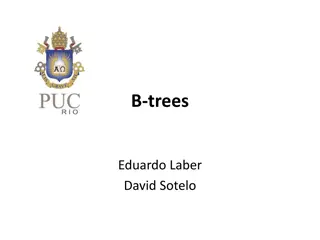All About Sumac Trees: Features, Uses, and Care Tips
Sumac trees, known for their shrubs and small trees with clusters of reddish drupes, are commonly found in North America and Africa. These trees, comprising approximately 250 species, are used for landscaping but some species can cause skin irritation. With minimal care requirements, sumac trees can enhance landscapes with their brilliant fall foliage. Avoid toxic species when considering sumac for landscaping.
Download Presentation

Please find below an Image/Link to download the presentation.
The content on the website is provided AS IS for your information and personal use only. It may not be sold, licensed, or shared on other websites without obtaining consent from the author. Download presentation by click this link. If you encounter any issues during the download, it is possible that the publisher has removed the file from their server.
E N D
Presentation Transcript
Sumac Tree Sumac Tree http://t3.gstatic.com/images?q=tbn:ANd9GcQ5qIv3_JzCJKCasN7XWG1q7_CwG7ISeQ8JgRmJartJlnznIUHOeg
Sumac Tree Sumacs are shrubs and small trees that can reach a height of 1 10 metres (3.3 33 ft). The leaves are spirally arranged; they are usually pinnately compound, though some species have trifoliate or simple leaves. The fruits form dense clusters of reddish drupes called sumac bobs. The dried drupes of some species are ground to produce a tangy purple spice.
http://t3.gstatic.com/images?q=tbn:ANd9GcQGSPJqVKU0PSM333yflaZdZeqDn2UD5vgJ_hV_b-TfBa_8nJriughttp://t3.gstatic.com/images?q=tbn:ANd9GcQGSPJqVKU0PSM333yflaZdZeqDn2UD5vgJ_hV_b-TfBa_8nJriug
http://upload.wikimedia.org/wikipedia/commons/thumb/6/61/Rhus_copallinum.jpg/150px-Rhus_copallinum.jpghttp://upload.wikimedia.org/wikipedia/commons/thumb/6/61/Rhus_copallinum.jpg/150px-Rhus_copallinum.jpg The flowers are in dense panicles or spikes 5 30 centimetres (2.0 12 in) long, each flower very small, greenish, creamy white or red, with five petals.
Commonly found in North America and Africa, sumac trees grow abundantly in the wild. They are also used for ornamental purposes, due to the attractive fall foliage color.
There are approximately 250 species of flowering plants that are known by the name sumac. They are used for various purposes besides being an ideal tree for landscaping. However, the popularity of the sumac tree is somewhat marred by some toxic species, which can cause severe skin irritation and rash, if touched. Many people simply prefer to stay away from the sumac for this very reason.
Sumac trees are usually easy to prune and care for, due to their small size. The plant requires minimal care and maintenance. Besides this, the plant with its brilliant fall foliage can truly enhance the look of a landscape. However, while considering sumac as a landscaping plant, avoid the poisonous species, which are harmful to touch.
http://t2.gstatic.com/images?q=tbn:ANd9GcRdrENJdSUzkD72513N9u5AIQKcczp4IM8LfRrC2zJqF-koZDGHhttp://t2.gstatic.com/images?q=tbn:ANd9GcRdrENJdSUzkD72513N9u5AIQKcczp4IM8LfRrC2zJqF-koZDGH Care Instructions The main attraction is its fall foliage, which makes it ideal for landscaping purposes. The tree can truly create one of the best spectacles in the fall, when its leaves turn bright red.
http://t3.gstatic.com/images?q=tbn:ANd9GcQGSPJqVKU0PSM333yflaZdZeqDn2UD5vgJ_hV_b-TfBa_8nJriughttp://t3.gstatic.com/images?q=tbn:ANd9GcQGSPJqVKU0PSM333yflaZdZeqDn2UD5vgJ_hV_b-TfBa_8nJriug
Thank You By: Lavanya Thammaiah. T. Smart Class Co-ordinator ,General Thimayya Public School, Madikeri























